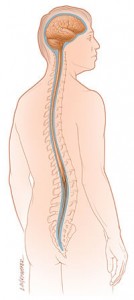 The cranium is the skull and the sacrum is the “tailbone,” the last bone in the spine—giving rise to the term: CranialSacral therapy.
The cranium is the skull and the sacrum is the “tailbone,” the last bone in the spine—giving rise to the term: CranialSacral therapy.
People think of the skull as rigid and static—as a fixed structure that perches atop a flexible, moving spine. Yet, osteopathic research has shown that the bones in the head move automatically and rhythmically in coordination with movements of the spine and sacrum.
Through trauma or stress, this normal pulsing of the cranium can become impaired or blocked, however, often causing pain that may be severe and intractable. Such blockage may also contribute to other kinds of dysfunction, such as nervousness, depression, or digestive difficulties. Blockages can also affect glands housed in the skull such as the pituitary gland, compromising the immune system.
CranialSacral therapy applies specific, gentle pressure in order to treat imbalances, poor alignment, or impaired motility in the body. These therapeutic movements are never high-velocity, rough, or invasive.
CranialSacral therapy can be beneficial in treating chronic pain, depression, and other dysfunctions. It is useful in treating infants for birth trauma, colic, “fussy baby syndrome,” chronic ear infections, and “failure to thrive.” It is also often helpful for children with learning disabilities and allergies. Elderly people often find that CranialSacral therapy yields greater flexibility, energy, and functionality.
At RSM Physical Therapy at Asclepeion Center, we see CranialSacral therapy as an important application of the Dynamic Colloid Fluid Model of the body. By this we mean that CranialSacral techniques can assess and treat bodily tissues that have retained the imprint of trauma or stress—tissues that are literally “holding on” to pain producing patterns. The gentle intervention of CranialSacral therapy can release this imprint and allow the tissues to regain a more normal state, alleviating tension, pain, and stress.




